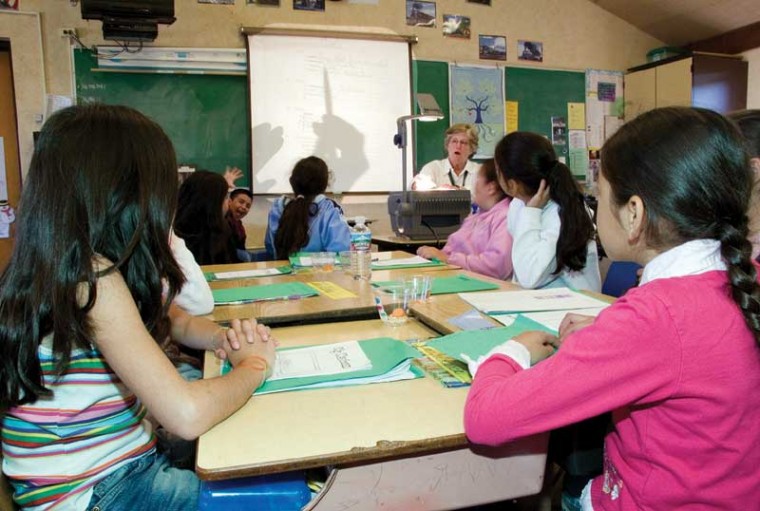Hollister
– Two historically low performing Hollister elementary schools
are using grant money to provide additional training to their
staff, and are hoping it will result in an increase in student test
scores.
Hollister – Two historically low performing Hollister elementary schools are using grant money to provide additional training to their staff, and are hoping it will result in an increase in student test scores.
R.O. Hardin and Calaveras schools are in their third year of funding through what is now called the High Priority Grant Program. These state grants have allowed the schools to focus on staff development and meeting the needs of students. The schools’ scores have improved, but administrators and staff still worry the schools will fall short of federal goals under the No Child Left Behind Act.
Both schools received the grant after applying in 2004. The grant is available to the lowest performing schools in the state according to the California standardized testing exam.
The grant amounted to $400 per pupil, equaling $191,600 at Calaveras and $293,600 at R.O. Hardin last year. Both schools have received nearly $1 million since 2004. The money goes to funding staff training and development to improve student test scores. The additional funds appear to have helped increase scores at both schools.
In the two years of testing since 2004, Calaveras has improved its academic performance index, or API, from 603 to 667. R.O. Hardin has increased from 620 to 647. API is measured on a scale of 200 to 1,000, with a target of 800. All schools are expected to reach the 800 API mark by 2013. The average API score in the Hollister school district is 718. The highest performing school in the district, Cerra Vista, scored 787 in 2006.
In the district, Calaveras had some of the largest improvement, seeing an increase of 64, while R.O. Hardin’s improvement of 44 was about average for the district. Gabilan Hills saw the most improvement in its district, increasing its score by 83 points to 721. Despite their improvement, the schools’ scores were still the lowest performing in the district.
The teacher training has been developed specifically to increase these scores. The teachers are given specific teaching methods and are provided with coaches who come and critique them in the classrooms. The teachers referenced various skills the development program had taught them, ranging from conceptual ideas, such as making sure all the teachers are using the same language, to specific teaching strategies.
Donna Rider, who has taught for seven years as a third-grade teacher at Calaveras, said the “reading tree” has been a helpful method given by the training. This helps teach her students reading comprehension, and will hopefully improve their scores on the state exam. With the reading tree, students use a visual of a tree and come up with “who, what, where, when and why” questions for the branches, while examining the text of the story.
Through the training program, the schools have also been provided with benchmark tests, so teachers can look at their individual students’ improvement, as well as their classroom overall.
“As a teacher, it showed us weak areas classwise,” said Donna Barry, a third-grade teacher at Calaveras who had just received some of the benchmark data back. “The first test, it showed we were weak in rounding, so we spent a little more time on that concept. It hones in on weak areas.”
Teachers at both schools are confident these improvements will be directly reflected in the school’s test scores. Both schools have improved since they received the grants, although they have not yet met the required yearly progress for English and language arts.
“I feel like the (staff development) has made a difference in our test scores. It’s been three years since we’ve had steady progress,” said Lilia Espinoza, vice principal at R.O. Hardin. “Although we haven’t met our goals per se, what we look at is the progress.”
Despite the yearly progress not being considered adequate by national standards, many parents do not feel this is an accurate picture of the school’s performance.
“(The test scores) can’t be a reflection of the school,” said Mary Chase, who has had five children attend R.O. Hardin. “We have such a large population of Spanish speakers, and the tests are in English – we have very bright, intelligent Spanish speakers that can’t read the test.”
R.O. Hardin and Calaveras have more English learners than other schools in the Hollister School District. According to the California Department of Education, in 2006, 51 percent of Calaveras students and 50 percent of R.O. Hardin students were English learners, compared with the 32 percent district-wide average.
The district’s administrators and staff at the two schools are hoping the teachers’ training will be reflected when the state tests are taken again in April.
“We’re in tune because we know that’s where our funding comes from,” R.O. Hardin fifth-grade teacher Trish Sparling said. “But all the staff would agree that we’re trying to teach kids, not robots. So we’re trying to teach to each child’s individual needs.”
Alice Joy covers education for the Free Lance. She can be reached at (831) 637-5566 ext. 336 or at aj**@***********ws.com.










